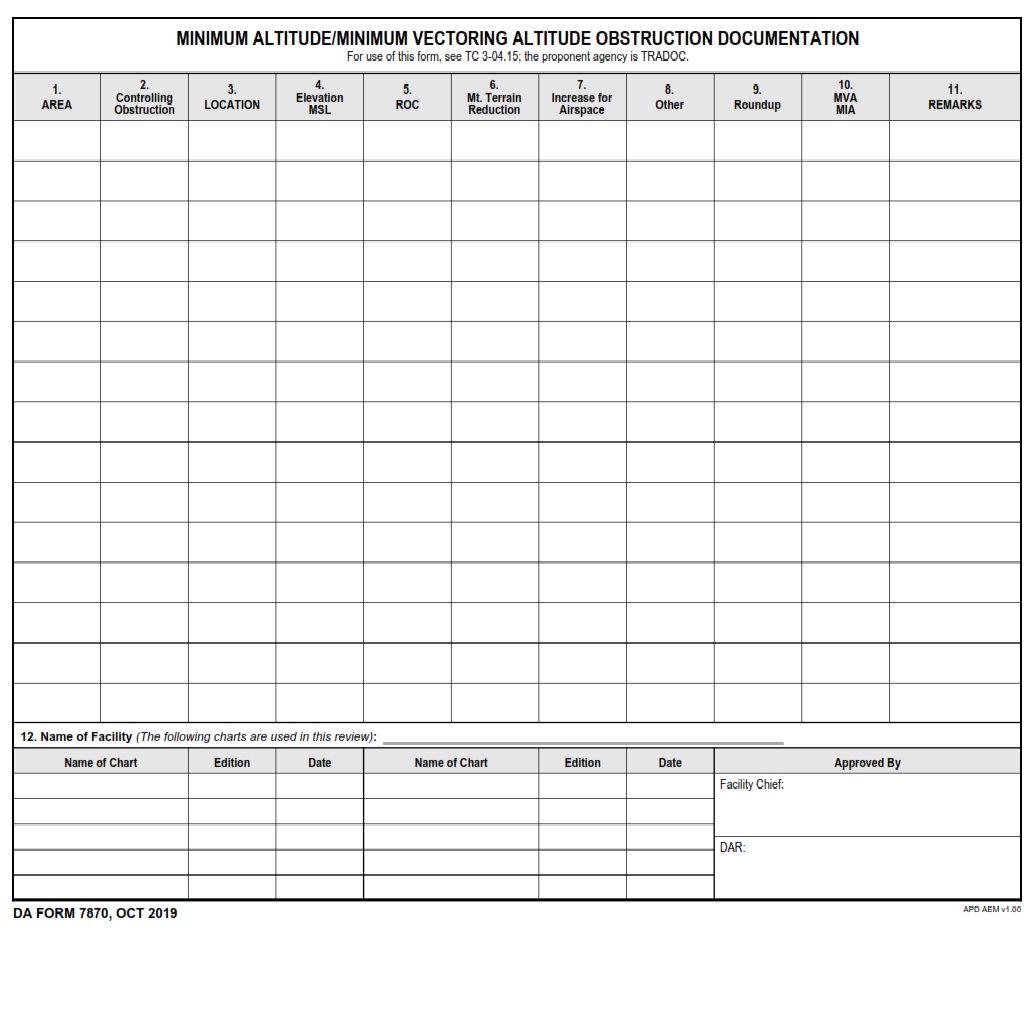Table of Contents
FREE-ONLINE-FORMS.COM – DA Form 7870 – Minimum Altitude/Minimum Vectoring Altitude Obstruction Documentation – DA Form 7870 is an important document that outlines the minimum altitude and minimum vectoring altitude obstruction documentation for aircraft. This form is used by aviation professionals to ensure safe and efficient flight operations.
The information in the DA Form 7870 includes critical details about obstacles that may obstruct the flight path of an aircraft, as well as recommended altitudes for flying in specific areas. By utilizing this form, pilots can properly plan their routes and avoid potential hazards that could jeopardize the safety of passengers and crew members on board. In this article, we will delve deeper into what the DA Form 7870 entails and why it is a crucial tool for those involved in aviation operations.
Download DA Form 7870 – Minimum Altitude/Minimum Vectoring Altitude Obstruction Documentation
| Form Number | DA Form 7870 |
| Form Title | Minimum Altitude/Minimum Vectoring Altitude Obstruction Documentation |
| Edition Date | 10/1/2019 |
| File Size | 202 KB |
What is a DA Form 7870?
A DA Form 7870 is used by the United States Army to document critical information regarding minimum altitude and minimum vectoring altitude obstructions. This form provides necessary data to ensure that aircraft are safely directed through potentially hazardous airspace. The DA Form 7870 is a reference point for pilots, air traffic controllers, and other personnel involved in flight operations.
It is essential to complete the DA Form 7870 accurately since it helps prevent accidents caused by obstacles such as buildings, towers, mountains, or other natural features that may pose a danger to airborne operations. The form contains vital details like obstacle locations, height above ground level (AGL), and their effects on flight routes. It also documents any changes or updates made concerning obstructions along the path of an aircraft.
The DA Form 7870 ensures safe navigation in military aviation operations. All personnel must understand its significance and importance when completing or reviewing its contents. Besides guiding on navigating around obstacles at high altitudes, it can help mitigate safety risks associated with low-level flying maneuvers like terrain-following missions or helicopter landing zones.
Where Can I Find a DA Form 7870?
If you are looking for a DA Form 7870, then there are several places where you can find it. The first place to check is the official website of the US Department of Defense, which has a comprehensive library of forms and documents related to military operations. You can also search other government websites dealing with aviation or air traffic control.
Another option is to contact your local military base or installation to see if they have copies of the form. They may be able to provide you with a physical copy or direct you to an online source where you can download it.
Finally, private companies specializing in aviation-related services may also have copies of the form available for download or purchase. These companies often work closely with military organizations and may have access to specialized forms like the DA Form 7870.
Overall, while finding a DA Form 7870 may require some effort on your part, there are several resources available where you can obtain this important document. Whether through government agencies or private companies, it’s important to ensure that all necessary documentation is in order when conducting military flight operations.
DA Form 7870 – Minimum Altitude/Minimum Vectoring Altitude Obstruction Documentation
The DA Form 7870 is a critical document in aviation that serves as an assurance of safety during flight operations. The form provides information on the Minimum Altitude and Minimum Vectoring Altitude (MVA) for a given area of operation. It also documents any obstructions, such as buildings or terrain features, that may affect flight paths.
The minimum altitude refers to the lowest height a pilot can fly above ground level while maintaining adequate clearance from any obstacles or structures. This value varies depending on factors such as aircraft type and weather conditions. On the other hand, the MVA is the minimum altitude at which air traffic controllers can instruct pilots to fly while providing vector guidance around an area of operations.
In addition to these values, the DA Form 7870 also includes documentation of obstructions that may pose risks to aircraft during takeoff, landing, and maneuvering phases. This information helps pilots make informed decisions about their flight paths and ensures safe navigation through restricted airspace or areas with high terrain elevation. Overall, compliance with this document significantly ensures safe and efficient aviation operations.
